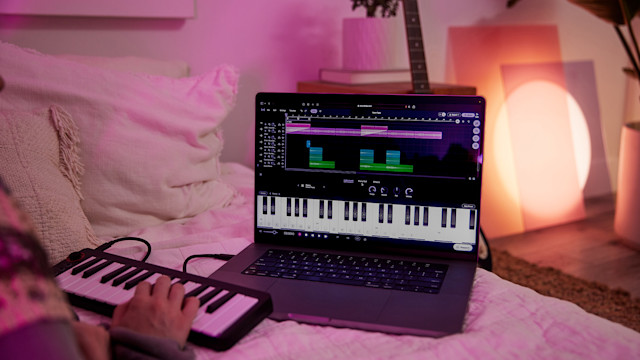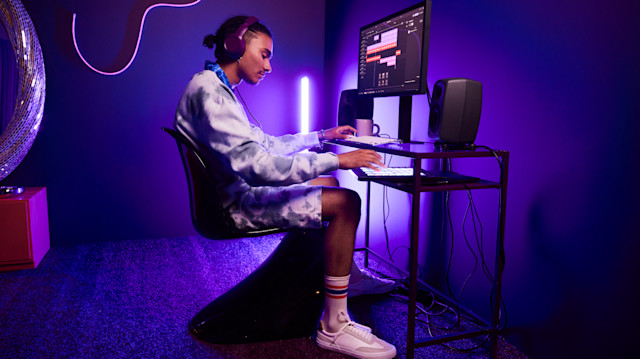Everything To Know About The Song BPM To Make Music
April 15, 2024 - Master the science of BPM in music production. Discover tools, techniques, and genre-specific guidelines to find the perfect tempo for your songs.

Understanding a song's beats per minute (BPM) is essential for dialing in the vibe and feel of the track.
In my experience, getting the BPM right is one of the most important decisions you make during production.
BPM measures the tempo of music, representing how quickly or slowly a piece is played. It's what makes you nod your head or tap your foot in time with the music.
As you explore different songs, you'll notice how BPM influences the mood and energy of each track. Some are ideal for a workout session, while others are better suited for a relaxed evening at home.
There are some easy ways to find out the BPM of the track; you can get close by estimating it yourself, however, there are tools that can help you find the exact BPM and key of any song effortlessly.
Many DAWs come with BPM detection capabilities.
Another option is to use online BPM finders. The process is simple: upload a file, and these services will analyze the audio and give you accurate BPM and key information.
Understanding BPM
The Basics of BPM
BPM represents the number of beats that occur in one minute of a song's playback— it's how you determine the song’s tempo. A higher BPM means a higher number of beats in a minute, translating into a faster pace.
Conversely, a lower BPM indicates fewer beats and a slower tempo. For example:
60 BPM: 1 beat per second, a slow ballad
120 BPM: 2 beats per second, often found in pop music
130 BPM or above: often used with energetic dance tracks
Measurement of a Song's BPM
To measure a song’s BPM, you can either use a metronome or a BPM counter application that allows you to tap along to the song’s beats. Some apps and digital metronomes automatically calculate the BPM for you as you tap.
For manual calculation, you start a timer, count the number of beats for 15 seconds, and then multiply that number by 4 to estimate the song’s tempo.
The formula looks like this:
Number of beats in 15 seconds × 4 = Song’s BPM
You can also find a song's BPM using online BPM finder tools. Input the track, and the service analyzes the tempo for you.
Technical Tools
BPM Finder
There are many great BPM finders available online that allow you to identify a song's tempo automatically. You can typically search by artist, song, genre, or mood and receive the BPM information without the need for manual tapping.
Tunebat is one example of a BPM finder
BPM Tapper
If you prefer to determine the BPM manually or want to verify machine-generated results, a BPM tapper is your go-to tool. You simply tap to the beat of the song, and after several taps, the tool calculates and displays the BPM.
For the most accurate BPM, continue to tap along with the song for an extended period.
BPM online is one example of a BPM tapper
Key Finder Tool
Key Finder Tools are utilities that analyze your audio files to determine the key of each track. Knowing a song's key is useful for harmonic mixing and can aid in producing smooth and pleasing transitions between songs.
Typically, key finder tools accept all the common audio file formats.
While a song's key doesn't affect the BPM in any way, these two properties work closely together to determine the energy and emotion of music overall.

Music Genres and BPM
Electronic and Dance Music
In Electronic and Dance Music genres, BPM plays a pivotal role in distinguishing subgenres and providing the rhythm that dancers follow.
Here's a simple guide:
UK funky: Typically around 130 BPM.
Techno: Ranges broadly from 120-160 BPM, commonly settling between 120-135 BPM.
Acid Techno: Falls within 135-150 BPM.
Dubstep: Often cited mistakenly at 140 BPM; more accurately fluctuates from 70's to 100 BPM, frequently in the 80-90 BPM range.
House: Ranges from 115-130 BPM.
Techno/trance: 120-140 BPM is the common tempo range.
Drum and bass: Fast-paced at 160-180 BPM.
Classical Music and BPM
In classical music, musical terminology from the Italian language suggests a range of BPMs to convey the composition's mood and pace instead of determining an exact BPM.
Here are some of the most commonly used musical terms you might encounter in sheet music or discussions about classical works:
Grave: Very slow, 25-45 BPM.
Largo: Very slow and broad, 40-60 BPM.
Adagio: A moderate slow tempo, 66-76 BPM.
Moderato: Moderately, 108-120 BPM.
Allegretto: Moderately fast, 112-120 BPM.
Allegro: Fast, 120-168 BPM.
Presto: Very Fast, 168-200 BPM.
BPM in Professional Settings
Music Producers and BPM
Finding the right BPM is one of my key decisions when working on a music production project.
Whether you're aiming for a relaxed ballad at 60 BPM or an energetic dance hit at 130 BPM, setting the correct BPM is fundamental to guiding the musicians and aligning the audio files during production.
You should always consider the genre's standard tempo ranges—for example:
Hip-hop: 60-100 BPM
Pop: 100-130 BPM
Dance: 120-130 BPM
Drum and Bass: 160-180 BPM
The Importance of Finding the Right BPM
When it comes to creating the perfect ambiance or driving energy in your music production, getting the BPM just right is crucial.
So how do you find that sweet spot?
Natural Fit
Firstly, understanding your music genre's natural cadence and feel is essential. I always experiment with different BPMs until it feels just right for the track I'm working on.
Use the standard tempo ranges we talked about earlier to find the ballpark of the BPM, then keep adjusting it until you find the tempo that's a natural fit.
The Audience's Heart Rate
This might sound a little far-fetched, but it's based on real science:
The BPM of songs can directly influence body time or the pace at which your heart beats. This is similar to the way a slightly faster cadence in a playlist can enhance a workout. For instance, songs in the 120-140 BPM range are often considered ideal for workouts due to their uplifting and energetic nature.
Imagine an audience at a rave or a nightclub. They're not there to chill, are they? The energy at a rave is probably at a similar level to a group workout, and I bet if we were able to monitor the audience's heart rate, it would also be similar.
When you match the BPM to the audience's heart rate you'll be more likely to create a stronger emotional connection with them.
Playlists
So you worked hard to produce a song, and it got released on Spotify. How do you get the song in the hands of new fans?
A big part of how listeners discover new music is through playlists. The playlists are typically based on genres, so the importance of getting the BPM right becomes more obvious when you think about it; if the BPM of your production is within the typical range for the genre, it will most likely fit in better with the rest of the playlist.
DJ Set
Similarly to playlists, DJs look for songs with matching energy levels and tempos so they can create smooth transitions and maintain a consistent mood.
They have the tools and skills to make tempo adjustments and match on the fly; however, your track must still be within the standard tempo ranges. Otherwise, the DJ could have a hard time matching the tempo of the tracks, and they might skip yours as an option.
How To Adjust Tempo In A DAW
All modern DAWs give you the ability to easily adjust the tempo.
In Soundtrap, the tempo control is next to the Metronome On/Off button at the bottom of the Studio screen. It's set to 120 BPM by default. When you click the number, you can change the tempo by entering a number, clicking the plus or minus buttons, or tapping.
You can also use the Time Stretch feature to change a region's tempo. This is especially helpful if you want to import an audio file that doesn't match your project's tempo.
Conclusion
Finding the right BPM is paramount to crafting the perfect ambiance and energy with your tracks. Whether you're producing electronic music or classical compositions, BPM acts as the heartbeat of your creation, dictating the pace and mood.
If you need to find out a track's tempo, many online tools help you easily identify it.
Aligning the BPM with the audience's heart rate can establish a profound emotional connection. Following the typical BPM ranges for different genres will get you in the right ballpark, and you can hone the rest by feeling the track and trusting your instincts. Dialing in the correct BPM within the genre's specific range is crucial.
Mastering the BPM can help elevate your music production to the next level, resonating deeper with your audience and delivering a more memorable musical experience.
About the author
Tero Potila is a professional music composer and producer. His career combining knowledge and experience from music, TV, film, ad, and game industries gives him a unique perspective that he shares through posts on teropotila.com.
Read more on Beat Making
Guide: How To Make A Boom Bap Beat With An Online DAW
Beginner's Guide to Lo-fi Music: Tips for Creating Lo-fi Beats Step-by-Step
How to Produce Music: The Complete Guide to Drift Phonk
What Is Chiptune And How To Make Chiptune Beats
What Is Drill Music & How To Make Your Own UK Drill Beats in 6 Steps
How To Make Dark Trap Beats With Fabian Mazur
Remake Doja Cat’s ‘Need to Know’ Beat in Soundtrap
Beatmaking Guide: The History of, and How to Make Afrobeats
How to Make Drum and Bass with an Online DAW
Get started with Soundtrap today!